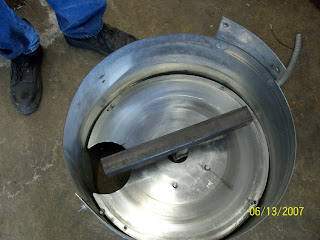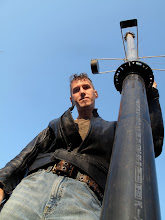
It's already time to gear up for the 2009 Festival and this time the project is to bring a sound element to an Alfombra (flower carpet). It's going to be a fabulous collaboration with Mark and Angie at the City of St. Paul Park and Rec Division and I'll be working with Liz's students at Patrick Henry High School to make sounds using vegetables and natural materials. All under the caring attention of Kirsten and Shelley at the Ordway.
Here's the initial project description that will undoubtedly morph:
THE SINGING GARDEN
Sound installation for Ordway Flint Hills International Childrens Festival, May 26-31, 2009
The Singing Garden is a sound-art installation that musically animates the 50-foot diameter alfombra flower carpet/garden walk located in the street near Landmark Center. Developed in residency at Patrick Henry High School it combines fantasy, research and science to imagine and realize the acoustic potential of plants and vegetables.
VEGETABLE CRITTERS
Speakers hidden inside the flower/petal beds will play sounds recorded by high school students made only using vegetables and plant materials. Battery-operated mp3/CD playback systems will mimic imaginary animal sounds, as though creatures are communicating across the whole space. Visitors will be encouraged to listen carefully and hear the space come alive as though it were a jungle dawn chorus or swamp at dusk.
We will begin the school residency by listening to recordings of some of the bizarre sounds made by birds and animals when communicating. We will explore how language is used in human social interactions and use that as a model for composing the conversations in sound.
We will see examples of music and sound made using vegetables; from the Vienna Vegetable Orchestra to Hmong leaf-blowing (grass-blade buzzing). We will provide vegetables and tools to make a variety of instruments together. Students will also be encouraged to create their own vegetable instruments and practice them for live classroom improvisations and solo recordings. Approximately 10 solos will be recorded, with lots of space and silence between sounds so that when all 10 are played back, they seem to be talking to each other. Each recorded solo (10-15 mins?) will then be encoded on CD or MP3–one for each playback device–placed hidden inside, behind or under the flower structures, and set up to repeat throughout the days of the festival.
In addition to the solo “sound” recordings, we will improvise, compose and record an ensemble of vegetable instruments that will play “music” at regular intervals through the day.
Examples of vegetable instruments include watermelon drums, ginger flutes, carrot and bell pepper trumpets, daikon slide whistles, leek flappers, eggplant guiros, coconut marimba, and jicama ocarinas. These can be made with simple drills and modeling knives and we learn acoustic principles in the process (and can eat the leftovers).
SPINNING FLOWER BEDS
Six of the 8 foot beds will be slightly raised and rotate slowly on motors. With the addition of one or more pegs on the perimeters we have the opportunity to make automated striking mechanisms. We will explore possible designs and materials that will make interesting sounds when a hammer is raised and dropped onto them; perhaps a bamboo rattle, struck gourd drum, stone lithophone, or ratcheted rainstick. We will learn some physics and mechanics with this.
There will be a mosaic bench and copper tree next to the pathway; we will include sounds made by tiles and copper in the recordings played back in those locations.
If topiaries are available, placed around the perimeter, we will hide speakers near them so that they join in the plant conversations.
These recordings will together make a harmonious whole; since birds and animals tune their voices to fill a specific acoustical niche we will also orchestrate our sound varieties so they do not compete for attention.
PLANT MUSIC
We will explore ways to amplify the sounds of living plants themselves through technology:
1. Taking a field trip to the Harriet Island worm compost pile and inserting contact mics to record the sounds.
2. Visiting St. Paul’s Como Conservatory Tropical Exhibit to record micro-sounds of plants and animals.
3. Experimenting with placing contact mics on trees to record the sound of water and nutrients rushing through the xylem (this will vary with the light and weather). This could be a live installation high up in the branches of the birch trees at the site, with listeners wearing headphones to listen to the tree breathing, live.
4. We will experiment with attaching electrodes to philodendron or bird-of-paradise leaves, connected to EKG or GSR sensors that output voltage to a preamp and medical software. This will output MIDI signals to a computer so that people can approach the living plant and touch the leaves to “play” it like an instrument. This is an astonishing phenomenon that shows how plants react to local stimuli and appear to have moods according to how they are treated.
5. We will set up two microphones at either end of a gravel pathway and record people walking and running. These recordings will then be played back at either end of the (non-gravel) path to give the illusion of different materials at visitors’ feet.
HANDS-ON ACTIVITIES
Students may like to demonstrate making vegetable instruments during the festival week and teaching others how to make similar ones, especially those that are quick, easy, and safe to make (eg, a drinking straw oboe reed or buzzed grass blade).
Students are welcome to make plant costumes and hats covered in real moss, flower petals, woven grasses, etc. and wear them during the festival activities or perhaps during a live performance.
TIMETABLE
8-10 school meetings (weekly, after-school sessions, any number of participants)
late-February – May (20-30 contact hours + prep time)
MATERIALS
R&D vegetable purchases for developing instrument ideas
Fresh vegetables supplied for each session.
Carving tools as needed.
10-15 self-powered playback devices: Mp3, batteries, self-powered speakers (waterproof)
contact mics, electrode sensors, software to experiment with plant sounds.
Headphones/amps, cabling
Wooden/metal mechanism for spinning beds
Recording equipment and audio editing
(40-60 hours R&D research time)




